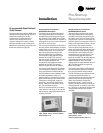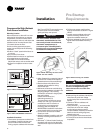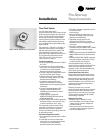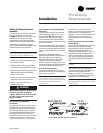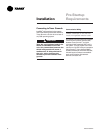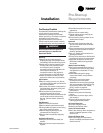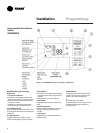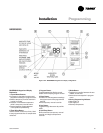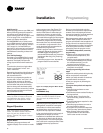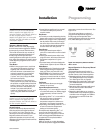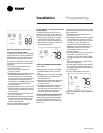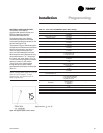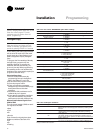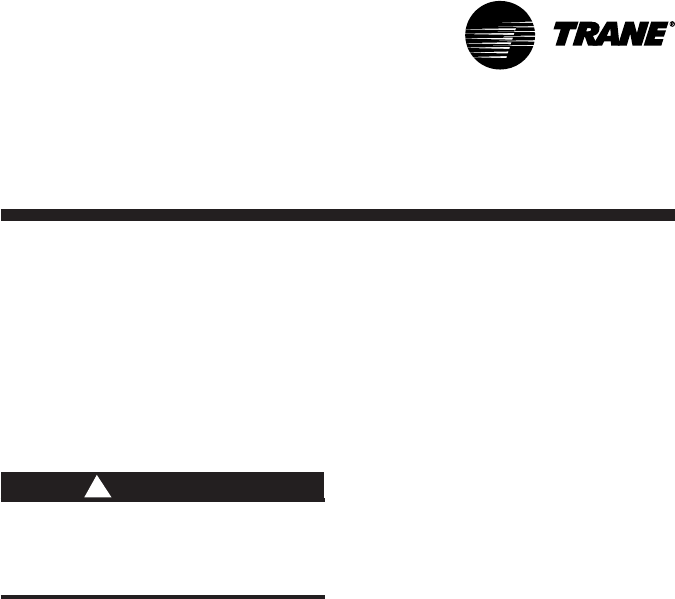
SCXG-SVX01B-EN 63
Pre-Startup
RequirementsInstallation
Pre-Startup Checklist
Complete this checklist after installing the
unit to verify all recommended
installation procedures are complete
before unit start-up. This does not replace
the detailed instructions in the
appropriate sections of this manual.
Always read the entire section carefully
to become familiar with the procedures.
Disconnect electrical power to
prevent injury or death from
electrical shock.
Receiving
oInspect unit and components for
shipping damage. File damage claims
immediately with the delivering carrier.
oCheck unit for missing material. Look
for ship-with drives, isolators, filters,
and sensors that are packaged
separately and placed inside the main
control panel, fan section, or
compressor section. See page 9 for
more information on ship-with items.
oCheck nameplate unit data to verify
against the sales order requirements.
Unit Location
oRemove crating from the unit. Do not
remove the shipping skid until the unit is
set in its final position.
oEnsure the unit location is adequate for
unit dimensions, ductwork, piping, and
electrical connections.
oEnsure access and maintenance
clearances around the unit are
adequate. Allow space at the end of the
unit for shaft removal and servicing.
See the “Service Access” section on
page 11.
Unit Mounting
oPlace unit in its final location.
oRemove shipping skid bolts and skid.
oIf using isolators, properly mount using
the isolator placement sheet.
oRemove shipping brackets on the
compressors and supply fan.
oRemove the unit protective shipping
covers.
Component Overview
oVerify the fan and motor shafts are
parallel.
oVerify the fan and motor sheaves are
aligned.
oCheck the belt tension for proper
adjustment.
oEnsure the fan rotates freely.
oTighten locking screws, bearing set
screws and sheaves.
oEnsure bearing locking collars do not
wobble when rotated.
Ductwork
oIf using return ductwork to the unit,
secure it with three inches of flexible
duct connector.
oExtend discharge duct upward without
change in size or direction for at least
three fan diameters.
oUse a 3” flexible duct connection on
discharge ductwork.
oEnsure trunk ductwork to VAV boxes is
complete and secure to prevent leaks.
oVerify that all ductwork conforms to
NFPA 90A or 90B and all applicable
local codes
Water-Cooled Unit Piping
oVerify the condensate drain piping is
complete for the unit drain pan. Install
and tighten the condensate “P” trap
drain plug.
oInstall water piping drain plugs,
economizer header, and condenser
vent plugs.
oMake return and supply water
connections to the unit and/or
waterside economizer piping package
with recommended valves and piping
components. Refer to the “Water
Piping” section on page 34.
oInstall unions to allow waterside
maintenance.
oInstall cooling tower and standby
pumps.
oTreat water to prevent algae, slime,
and corrosion.
oPrevent refrigerant piping from
rubbing against other objects.
Air-Cooled Units Only
oConnect refrigerant lines.
oInstall liquid line filter driers.
Units with Hydronic Heat
oVerify the entering water temperature
sensor is installed upstream of the
hydronic coil.
Units with Electric Heat
oVerify the supply air temperature
sensor is installed downstream of the
electric heat coil.
ƽƽ
ƽƽ
ƽ
WARNING
!



